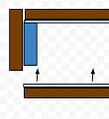Difference between revisions of "Infinity Portal"
| Line 56: | Line 56: | ||
File:portalBuild16.jpg|Pulling the protective coating off of the acrylic | File:portalBuild16.jpg|Pulling the protective coating off of the acrylic | ||
</gallery> | </gallery> | ||
Building the framework took about 5 8-hour work sessions. We used the pallet that the acrylic came in on as a base for the framework. | |||
We ordered the 4x8 sheets of acrylic from Reflection Products in Roswell, Ga. Everything else for the frame was custom-built from the local hardware store. | |||
== Step 5: Building the electronics == | == Step 5: Building the electronics == | ||
Revision as of 21:10, 6 April 2014
The Infinity Portal is an interactive art project build for Alchemy.
The concept of the project centers on an infinity mirror, which is an optical effect created by placing a two-way mirror in front of a regular mirror. Any light source between the two mirrors appears to be reflected forever because only some of the light escapes the two-way mirror. The rest is reflected back, so the viewer's eyes sample the internal reflections in the mirror.
The idea for this project is to create a large archway that appears to be a freestanding gateway standing on an altar. People walk up to the gate, triggering a proximity sensor. Once the system detects that a user is present, the LED strips inside the infinity mirror are triggered, giving the appearance of a portal having opened in the gate and extending backwards infinitely.
Step 1: Prototyping the concept
The first round of prototyping involved testing the concept, so we built an Infinity Mirror from parts around the shop, a hardware store run, an LED strip, and some mirror tint ordered online.
We posted a write-up of the build on our blog, which was then featured on Hack A Day.
We had some good finds from the initial prototyping, and found that we can change the apparent depth of the tunnel by changing the brightness of the LEDs or spacing the two mirrors farther apart. We can make the tunnel appear to curve around by tilting the mirrors slightly. By using two of the two-way mirrors, we found that we could project into the back of the enclosure to make a projected image repeat indefinitely.
Step 2: Prototyping the design
Next, we built a prototype that Tam sketched as a conceptual rendering of the final model. To do this, we vector-mapped her sketch, processed it in CamBam, exported the gcode to the laser cutter and cut a prototype out of wood.
We used the two prototypes that we had (conceptual and design) at the Alchemy Art Fundraiser and received the highest funding at that event. We've still got some fundraising to do, but it looks like people are really excited about this concept!
Step 3: Planning the Build
The build will probably be divided into a few different processes that we'll work on independently:
- Building the framework to support the reflective acrylic pieces
- Designing and milling the facade for the front of the archway
- Programming the light controllers with rainbow chase patterns and setting up triggers
- Laser engraving the acrylic accent pieces for the archway
- Building the Altar and testing different setups to support the illusion
Step 4: Building the framework
Building the framework took about 5 8-hour work sessions. We used the pallet that the acrylic came in on as a base for the framework.
We ordered the 4x8 sheets of acrylic from Reflection Products in Roswell, Ga. Everything else for the frame was custom-built from the local hardware store.






























